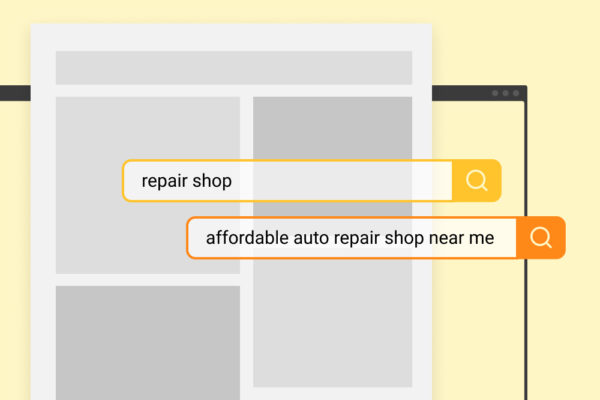Read just about any blog post, magazine article, or book about building a successful business, and one word will pop up over and over: niche.
In order to differentiate your business from the competition and show customers that they want what you have to offer, you have to niche down in some way. That could mean targeting a specific geographic area, honing in on distinct user demographics (age, gender, interests) or doing something extra specific that other companies aren’t doing, like donating a portion of sales to a certain organization.
In terms of SEO, long-tail keywords are so much more niche than short-tail keywords, and just like with your business, that specificity is what makes them so powerful.
Let’s go over the differences between short- and long-tail keywords, so you can decide what to focus on for your SEO strategy.
What Is a Short-Tail Keyword?
A short-tail keyword is a total of one or two words, like “wedding photographer” or “productivity software.” Short-tail keywords are common, even if they’re not as effective as long-tail keywords. Because they’re so common, there’s a lot of competition out there. Meaning, there are tons of other websites that are using and ranking for the same short-tail keywords.
What Is a Long-Tail Keyword?
A long-tail keyword is a phrase consisting of around four or five words (sometimes more), like “wedding photographer in Boston” or “productivity software for small business.” In the SEO world, those few extra words have a major impact. The more exact the term that’s searched for, the more exact the match in search results, which means the user is more satisfied than if they found something that doesn’t quite hit the mark.
Long-tail keywords are used less often, which means competition is low, and you have a better chance of ranking highly for that term. Now, if you pit a high-ranking short-tail keyword against a high-ranking long-tail keyword, yes, the short-tail keyword will get many more hits. However, even if you get a lower quantity of hits for a long-tail keyword, the hits you do get will be higher quality because the user intent is more specific, and you’ve met it with your SEO.
Which Type of Keyword Is Better?
For marketing purposes, particularly B2B marketing, long-tail keywords are generally more worthwhile. They reflect how your target audience thinks and the words they use to search for your type of products or services.
In contrast, short-tail keywords have two big strikes against them:
- They’re less specific, which means the customer is less likely to find exactly what they’re looking for.
- They’re widely used, so there’s a lot of competition out there, which makes it hard to rank your short-tail keyword.
Think of it this way: short-tail keywords may send more people to your website, but those people don’t have a high intent to buy. Long-tail keywords may send fewer people to your website, but those people are very close to making a purchase. So, while you may have fewer visitors, you could make more sales.
Furthermore, long-tail keywords show that you understand your audience and you know what they’re looking for. Take the examples above. You’re not just a wedding photographer, you’re a wedding photographer in Boston. You don’t just sell basic productivity software, you sell productivity software specifically for small businesses. You could even take those long-tail keywords further by adding more description, like “contemporary wedding photographer in Boston” or “productivity software for accounting small business.”
Now, this doesn’t mean that you shouldn’t use any short-tail keywords in your copy. However, you shouldn’t depend on those keywords to help you rank any time soon. It can take a very long time to rank highly for short-tail keywords. Use both short- and long-tail keywords in your copy to build a strong SEO strategy for the present and the future.
How to Create an SEO Strategy with Keywords
Since you’re going to use some short-tail keywords – and plenty of long-tail keywords – in your content and marketing copy, let’s go over the best way to build a strategy.
First, choose one short-tail keyword. The one you choose is going to be the center of your keyword strategy. Let’s continue with one of our examples: productivity software. That’s your short-tail keyword.
From there, think of how to build on that short-tail keyword to create a selection of long-tail keywords that appeal to your customers: what they’re looking for, as well as their pain points. Here are a few ideas:
- productivity software for remote teams
- productivity software for small business
- productivity software for the travel industry
- productivity software for students
- productivity software for Windows
You can also flip the order of some of these – for example, “travel industry productivity software” or “Windows productivity software.”
You don’t have to think up all of the possible word combinations on your own, either. One of the quickest and easiest ways to come up with a list of long-tail keywords is to type your short-tail keyword into the Google search bar. Related searches will auto-populate like in the example below:

Then, once you click on one, scroll down to the bottom of the results page for even more ideas:

Here’s another tip: If you want to generate some content ideas for your upcoming blog posts or social posts, check out the “People also ask” box toward the center of the page. These are popular queries that are related to your long-tail keyword:

Although you don’t want to rely on Google alone, and you should also use a tool specifically for keyword research such as Ahrefs, this is an easy way to get started.
Wrapping Up
Ranking for specific keywords starts with identifying the keywords that coincide with what you’re selling or promoting and match your audience’s intent. Then, once you have a list of keywords to optimize for, use them throughout your digital content, from your blog posts and website metadata to your Facebook ads, YouTube videos and more.










